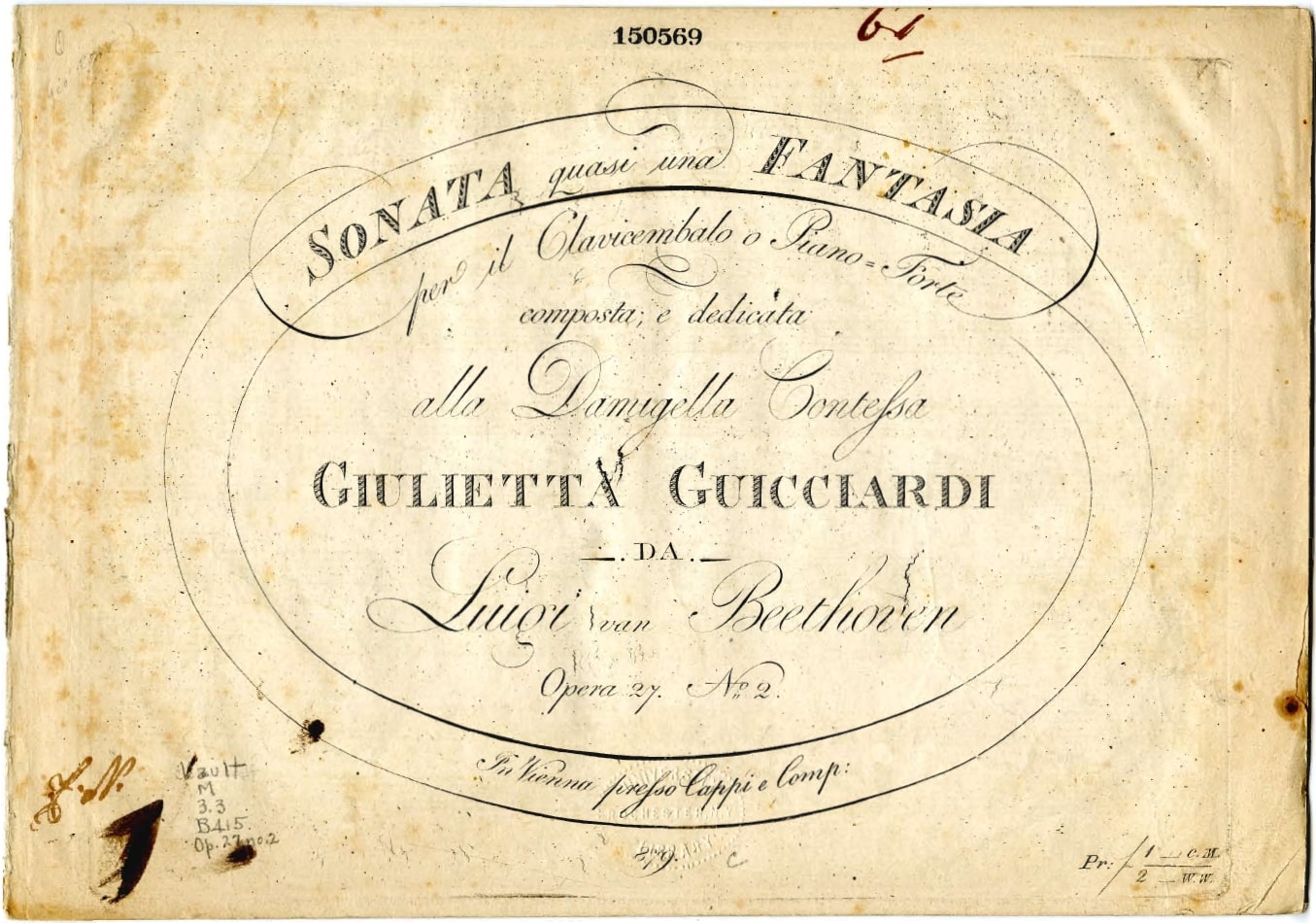 |
The title Moonlight Sonata actually didn’t come about until several years after Beethoven’s death. In 1836, German music critic, Ludwig Rellstab wrote that the sonata reminded him of the reflected moonlight off Lake Lucerne. Since then, Moonlight Sonata has remained the “official” unofficial title of the sonata.
Over and over in Beethoven’s music themes of victory over tragedy abound. In the internal struggle he faced, although his music showed the greatest despair and sorrow, it always transcended into a triumphant victory. With that same inner struggle, Beethoven learned to transcend deafness and still be victorious in creating greater and greater masterpieces. During the late 1790s, Beethoven’s music began to show changes, as well as enlargement of form. After the Heilgenstadt Testament, Beethoven expressed dissatisfaction with his compositions and according to Czerny was “determined to take a new path.” [1] The changes included strong links between sonata movements, intensified drama, harmonic instability, motivic elements affecting the larger form, twelve measure structures, registral gaps, recitative and pedal effects.
‘Sonata quasi una fantasia’ is the title Beethoven gave his fourteenth sonata. Unlike the formal Sonata form of the classical period, Fantasia commonly describes a free-form classical musical piece. Marking the beginning of Beethoven’s second stylistic period, opus 27 no. 2 does not follow the traditional sonata form. Beethoven additionally uses traditional musical mourning devices called Trauermusik, in a very untraditional way. Trauermusik consists of Lament Bass, repetitive accompaniment figures, and chant. Other famous examples of chant are Mozart’s Masonic Funeral Music and the Requium. Dotted monotone anacrusis permeate the first movement reminiscent of the tolling of funeral bells, recall the previous piano sonata Opus 26, Marcia sulla morte de’un eroe, which anticipates Chopin’s opus 35 Bb sonata’s famous ‘Marche Funebre’ and later the main theme of Beethoven’s ‘Eroica’ Symphony’s ‘Marcia Funebre’. What changes in Beethoven’s life led to these transformations in his music?
In 1800-1802 Ludwig van Beethoven experienced devastating internal turmoil in trying to come to terms with his hearing loss. To the outside world, his life seemed to be ideal, with his success as a virtuoso pianist and as a successful, sought-after composer in Vienna. He gradually began to withdraw from society and friends, however, as he felt it would be detrimental to his successful career as a musician if people found out he was going deaf. People felt he was being misanthropic, yet it was quite the opposite. Beethoven lived in a great deal of solitude and loneliness due to his impending and eventual complete deafness, which would eventually have a profound effect on his spiritual and creative growth as a composer and a musician. The years of 1800-1802 were a transformative period in Beethoven’s life and marked the beginning of his second stylistic period. As Beethoven’s outer hearing deteriorated, his inner hearing continued to grow.
Beethoven sought treatment in the village of Heilgenstadt in the late spring of 1802 until October of that year. Full of despair over the unsuccessful treatment, he considered ending his life. In a famous letter known as the Heilgenstadt Testament written to his brothers, he wrote “Thanks… to my art, I did not end my life by suicide.”
Over and over in Beethoven’s music themes of victory over tragedy abound. In the internal struggle he faced, although his music showed the greatest despair and sorrow, it always transcended into a triumphant victory. With that same inner struggle, Beethoven learned to transcend deafness and still be victorious in creating greater and greater masterpieces. During the late 1790s, Beethoven’s music began to show changes, as well as enlargement of form. After the Heilgenstadt Testament, Beethoven expressed dissatisfaction with his compositions and according to Czerny was “determined to take a new path.” [1] The changes included strong links between sonata movements, intensified drama, harmonic instability, motivic elements affecting the larger form, twelve measure structures, registral gaps, recitative and pedal effects.
This sonata could be interpreted as Beethoven beginning to come to terms with his impending eventual deafness. The mourning and loss of the Adagio Sostenuto with its modal changes, dissonances, rhythms, and chants representative of Trauermusik followed by the rage of the stormy third movement, were his way of expressing how he felt about this affliction of deafness while writing the most extraordinary music and not being able to hear it.
Beethoven would live most of his life in a great deal of loneliness and despair with most of his life devoted to the development of his art and creativity. As this sonata was written towards the beginning of his second stylistic period many masterpieces would follow the ‘Sonata Quasi Una Fantasia’.
Jamila Sahar
[1] Timothy Jones, BEETHOVEN The “Moonlight” and other Sonatas, Op 27 and Op 31, p. 15 http://www.theartofpianoperformance.com
Article Source: EzineArticles
|

No comments:
Post a Comment